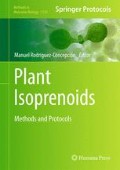Abstract
Heterologous and stable expression of genes encoding terpenoid biosynthetic enzymes in planta is an important tool for functional characterization and is an attractive alternative to expression in microbial hosts for biotechnological production. Despite improvements to the procedure, such as streamlining of large scale Agrobacterium infiltration and upregulation of the upstream pathways, transient in planta heterologous expression quickly reaches limitations when used for production of terpenoids. Stable integration of transgenes into the nuclear genome of the moss Physcomitrella patens has already been widely recognized as a viable alternative for industrial-scale production of biopharmaceuticals. For expression of terpenoid biosynthetic genes, and reconstruction of heterologous pathways, Physcomitrella has unique attributes that makes it a very promising biotechnological host. These features include a high native tolerance to terpenoids, a simple endogenous terpenoid profile, convenient genome editing using homologous recombination, and cultivation techniques that allow up-scaling from single cells in microtiter plates to industrial photo-bioreactors. Beyond its use for functional characterization of terpenoid biosynthetic genes, engineered Physcomitrella can be a green biotechnological platform for production of terpenoids. Here, we describe two complementary and simple procedures for stable nuclear transformation of Physcomitrella with terpenoid biosynthetic genes, selection and cultivation of transgenic lines, and metabolite analysis of terpenoids produced in transgenic moss lines. We also provide tools for metabolic engineering through genome editing using homologous recombination.
Access this chapter
Tax calculation will be finalised at checkout
Purchases are for personal use only
References
Viana AAB, Pelegrini PB, Grossi-de-Sá MF (2012) Plant biofarming: novel insights for peptide expression in heterologous systems. Pept Sci 98:416–427
Anterola A, Shanle E, Perroud PF et al (2009) Production of taxa-4(5),11(12)-diene by transgenic Physcomitrella patens. Transgenic Res 18:655–660
Hamberger B, Bak S (2013) Plant P450s as versatile drivers for evolution of species-specific chemical diversity. Phil Trans R Soc B 368:20120426
Yonekura-Sakakibara K, Hanada K (2011) An evolutionary view of functional diversity in family 1 glycosyltransferases. Plant J 66:182–193
Liu Q, Majdi M, Cankar K et al (2011) Reconstitution of the costunolide biosynthetic pathway in yeast and Nicotiana benthamiana. PLoS One 6:e23255
Chen F, Tholl D, Bohlmann J et al (2011) The family of terpene synthases in plants: a mid-size family of genes for specialized metabolism that is highly diversified throughout the kingdom. Plant J 66:212–229
Aya K, Hiwatashi Y, Kojima M et al (2011) The Gibberellin perception system evolved to regulate a pre-existing GAMYB-mediated system during land plant evolution. Nat Commun 22:544
Anterola A, Shanle E (2008) Genomic insights in moss gibberellin biosynthesis. Bryologist 111:218–230
Johri MM (2008) Hormonal regulation in green plant lineage families. Physiol Mol Biol Plants 14:23–38
Simonsen HT, Drew DP, Lunde C (2009) Perspectives on using Physcomitrella patens as an alternative production platform for thapsigargin and other terpenoid drug candidates. Perspect Medicin Chem 3:1–6
von Schwartzenberg K, Schultze W, Kassner H (2004) The moss Physcomitrella patens releases a tetracyclic diterpene. Plant Cell Rep 22(10):780–786
Schaefer DG, Zrÿd JP (1997) Efficient gene targeting in the moss Physcomitrella patens. Plant J 11:1195–1206
Hayashi K, Horie K, Hiwatashi Y et al (2010) Endogenous diterpenes derived from ent-daurene, a common gibberellin precursor, regulate protonema differentiation of the moss Physcomitrella patens. Plant Physiol 153:1085–1097
Ashton NW, Grimsley NH, Cove DJ (1979) Analysis of gametophytic development in the moss, Physcomitrella patens, using auxin and cytokinin resistant mutants. Planta 144:427–435
Edwards K, Johnstone C, Thompson C (1991) A simple and rapid method for the preparation of plant genomic DNA for PCR analysis. Nucleic Acids Res 19:1349
Cove DJ, Perroud PF, Charron AJ et al (2009) The moss Physcomitrella patens: a novel model system for plant development and genomic studies. Cold Spring Harb Protoc 2009(2):69–104
Halpin C, Cooke SE, Barakate A et al (1999) Self-processing 2A-polyproteins—a system for co-ordinate expression of multiple proteins in transgenic plants. Plant J 17:453–459
Author information
Authors and Affiliations
Corresponding author
Editor information
Editors and Affiliations
Rights and permissions
Copyright information
© 2014 Springer Science+Business Media New York
About this protocol
Cite this protocol
Bach, S.S., King, B.C., Zhan, X., Simonsen, H.T., Hamberger, B. (2014). Heterologous Stable Expression of Terpenoid Biosynthetic Genes Using the Moss Physcomitrella patens . In: Rodríguez-Concepción, M. (eds) Plant Isoprenoids. Methods in Molecular Biology, vol 1153. Humana Press, New York, NY. https://doi.org/10.1007/978-1-4939-0606-2_19
Download citation
DOI: https://doi.org/10.1007/978-1-4939-0606-2_19
Published:
Publisher Name: Humana Press, New York, NY
Print ISBN: 978-1-4939-0605-5
Online ISBN: 978-1-4939-0606-2
eBook Packages: Springer Protocols

